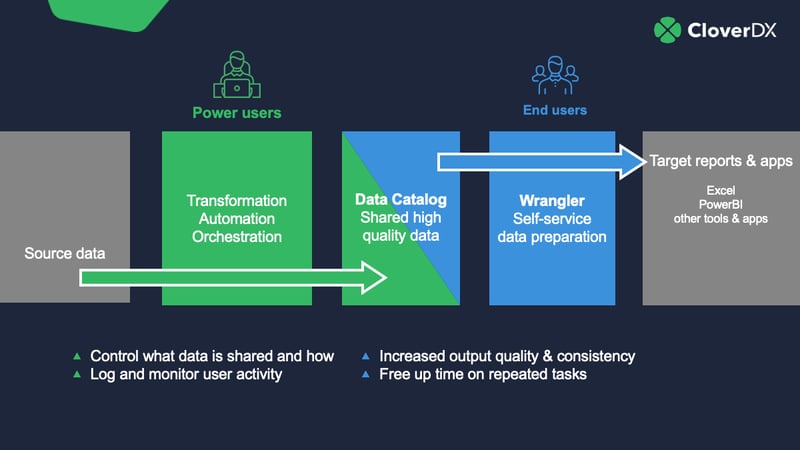The goal of the data-driven company is to extract as much value as possible from your data. But getting the right data to each business area in a usable format with compliance and quality intact comes with challenges:
- Raw data in the system is not user-ready and must undergo significant transformation before a less technical user can make use of it.
- Piles of data can go unused because the person who needs it doesn’t know it’s available or have a way to analyze it.
- IT is rightly slow to sacrifice ownership when they bear responsibility for the quality and security of company data.
- The way IT talks about data and the way a given business area discusses it can vary greatly. This creates an unnecessary chasm between those who manage data and those who use it.
Why does all this matter? Because, ultimately, data-driven organizations outpace their competitors. For example, a company focused on customer analytics is around twice as likely to generate ‘above average profits and market earnings’ per a McKinsey survey.
How you manage and share data determines if you take your company’s data from hoarded to helpful. This blog discusses what a live data catalog is and how it helps your business get the most from your data.
The traditional approach to a data catalog
A data catalog is a basic component of data management. It provides a business with an organized inventory of its data assets. Data users then search the catalog for the correct data for their analytical and business needs.
However, finding appropriate tools for building a data catalog can be challenging. Some solutions may not integrate well with your current data practices, making them disruptive and resource-intensive to implement. Tools that are not user-friendly can also prevent less technical users from serving themselves the data they need.
In the end, your company may get a library of data definitions. But the process is not agile and it may neglect factors like user experience or allowing data users direct access to data.
For a data catalog to be useful to your business, it must be more than a data management tick box. If you only pull it out to meet regulatory requirements, it doesn't deliver value. Your company needs a data catalog designed to be accessible and useful to business users.
What is a ‘live’ data catalog and why does it matter?
A live data catalog is an index of data that is continuously updated and which allows users easy access to the data they need.
A live data catalog in CloverDX
The IT team provisions, validates and designs data sources, in collaboration with data owners. This means:
- Business users have direct access to their data. This eliminates ad-hoc requests to IT. Data users can interact with data without assistance.
- Business users can collaborate better with IT. At the same time, a live catalog creates a shared language between IT and business users.
- The data is high quality. IT maintains control of the published data and users’ access cannot compromise its quality while working with data flows.
- The data is curated. IT can apply any filters or definitions to keep data sets consistent. For example, a customer list pulled straight from a CRM might pull in ex-customers, internal customers and test data. Via a data catalog though, any customer list can be filtered to be current customers.
- The data is in real time rather than static. Users no longer wait for the data to update or submit ad hoc requests to fill in the missing timeline for required information.
- The data is ready to use. Data is cleaned and prepared prior to entering the catalog. This means users can begin interacting with the data immediately.
87% of surveyed business executives said their company would be more successful once frontline workers were empowered in decision-making. Yet only 20% of those organizations had empowered and equipped workers to make ‘data-driven insights’ according to Harvard Business Review.
A live data catalog changes the landscape of your data management. It takes the catalog from a static, unusable list to an accessible asset that puts the power of information in the hands of your people.
The role of CloverDX’s live data catalog and Wrangler for your data management
The combination of CloverDX’s live data catalog and visual data interface Wrangler allows users, no matter their level of technical knowledge, to work on live data curated by your IT teams. Business users confidently interact with an intuitive interface without posing a risk to data quality.
We have helped several organizations empower their business users to interact with data and make informed decisions under the watchful eye of IT teams.
Want to discuss how our live data catalog and Wrangler could alter data management in your company to improve access to and the usability of data? Book a demo today.











